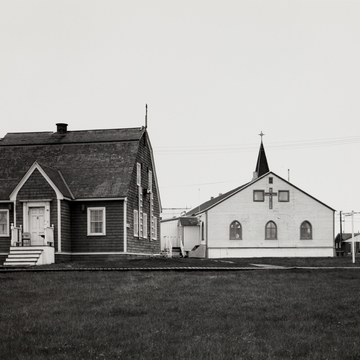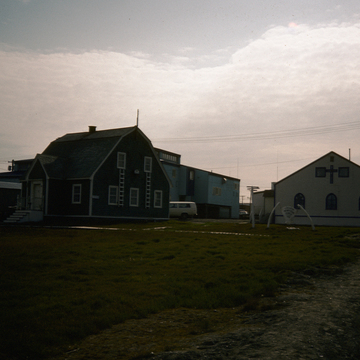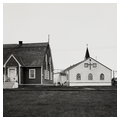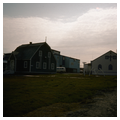Extraordinary in its setting, a wood-shingled Dutch Colonial house was constructed as the parsonage of the Utkeagvik Presbyterian Church. The church had been established by a Presbyterian missionary, L. M. Stevenson, in 1899. The present church building, a long low structure with a bell tower, was constructed about 1954, with the Christian education building behind dating from 1968. The manse is of more interest architecturally.
The previous manse burned down in 1925, and the pastor, Dr. Henry W. Greist, went on a fund-raising expedition Outside; on his return he stopped in Seattle to order lumber cut to the architect's specifications. The materials were shipped to Barrow and the house was erected in 1929–1930. Anne Morrow Lindbergh, who visited in 1930 while accompanying her husband to the Orient, described Greist's involvement in constructing the gambrel-roofed house:
He had built the manse in which we were staying. His son, “outside,” had helped him to plan it. The doctor himself, directing the Eskimos, had measured and fitted every board and nail.… Aside from his work as architect and carpenter, he preached every Sunday, had a Bible class Wednesday nights, was doctor, surgeon, and dentist, and was preparing his boy for college.
Greist took special precautions with the permafrost: “He had placed special insulation in the floor, for it was impossible to have a furnace in the cellar. If you started to thaw out the ground underneath, the house might sink. And a furnace would require too much fuel in a fuel-less country.”
The windows were triple paned, and a tube similar to the Russian fortochkas provided ventilation: “The windows, triple storm ones, were all nailed down. They were for light and not for ventilation. Windows that open and shut are always draughty. The rooms were ventilated by pipes which let in air indirectly but kept out rain and snow.”
The rest of the house, as well as the water, was heated by downstairs stoves: “Heat from the kitchen went up through ventilators in the ceiling to the bedrooms above. There were big stoves in all the rooms. The doctor installed the water tank, connected it with pipes for running water downstairs, and heated it from the stove.”
The values expressed by this American suburban home built in the Arctic were also captured by Lindbergh, here describing her entry:
I stamped my numb feet on the wooden steps of her home as she (Molly Greist) pushed open the door. The warmth of a kitchen fire, the brightness of gas lamps, and a delicious smell of sweet potatoes and freshly-baked muffins poured out around me and drew me in. A long table spread for our “Thanksgiving dinner” filled the living room. White cloth, rims of plates, curves of spoons, caught the light from swinging lamps above. I looked around quickly and felt the flavor of the American home—chintz curtains drawn aside, pictures of “woodland scenes” on the walls, bright pillows on the sofa, and there, in the window, a box of climbing nasturtiums. ( North to the Orient[New York: Harcourt Brace, 1935], pp. 100–103.)

















